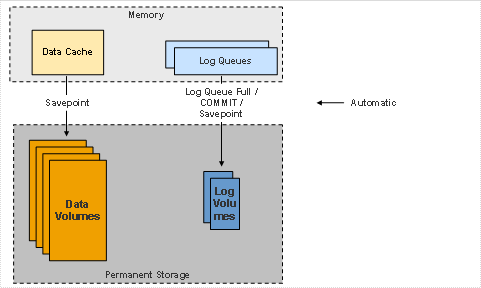 Data Storage
Data Storage 
How Does the Database System Store Information Physically?
If, in a transaction, a database user changes data in the database, the database system first stores the changed data in the data cache (in the working memory) and logs the changes in redo log entries in the log queue (in the working memory).
In the following situations, the database system (pager tasks) writes the data changes from the data cache to the data volumes:
● The data cache is too full (depends on, among other things, the relationship between the changed and read pages in the data caches)
● At savepoints
In the following situations, the database system (log writer task) writes the redo log entries from a log queue to the log volumes:
● The log queue is full.
● The transaction is closed with a COMMIT.
● At savepoints

Log pages in the log queue which were not full at the time of writing remain in the log queue, are filled and then written to the log volumes again during the next write process.
See
Working memory and permanent storage

Which Logical Organizational Structures Does the Database System Use?
The database system uses the following organizational structures to store data in the database:
● Page chains
● Pages in B* Trees
Logical organizational structures

How Does the Database System Assign Logical Information to Physical Pages?
The database system stores the assignments of logical data pages to physical addresses in the converter. See Converter.
See also:
Overview of the Database System
